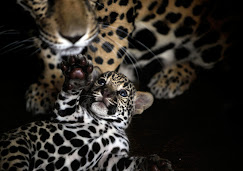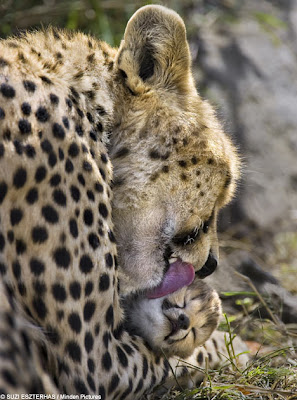Cheetah (acinonyx jubatus) is the fastests animals in the big cat family (felidae) most cheetahs are found in Africa and the middle east with their stilth and power they can stalk their prey for long distances.Upon catching their prey they tend to hide it on top trees away from other animals.
The cheetah is the fastest land animal in the world. They can reach a top speed of around 113 km per hour.
A cheetah can accelerate from 0 to 113 km in just a few seconds.
 Cheetahs are extremely fast however they tire quickly and can only keep up their top speed for a few minutes before they are too tired to continue.
Cheetahs are extremely fast however they tire quickly and can only keep up their top speed for a few minutes before they are too tired to continue.Cheetahs are smaller than other members of the big cat family, weighing only 45 – 60 kilograms.
One way to always recognise a cheetah is by the long, black lines which run from the inside of each eye to the mouth. These are usually called “tear lines” and scientists believe they help protect the cheetah’s eyes from the harsh sun and help them to see long distances.
Cheetahs are the only big cat that cannot roar. The can purr though and usually purr most loudly when they are grooming or sitting near other cheetahs.
While lions and leopards usually do their hunting at night, cheetahs hunt for food during the day.
A cheetah has amazing eyesight during the day and can spot prey from 5 km away.
Cheetahs cannot climb trees and have poor night vision.
 With their light body weight and blunt claws, cheetahs are not well designed to protect themselves or their prey. When a larger or more aggressive animal approaches a cheetah in the wild, it will give up its catch to avoid a fight.
With their light body weight and blunt claws, cheetahs are not well designed to protect themselves or their prey. When a larger or more aggressive animal approaches a cheetah in the wild, it will give up its catch to avoid a fight.Cheetahs only need to drink once every three to four days.
Africa ’s spotted sprinter
 Wildlife parks in
Wildlife parks in Africa help protect some of the cheetahs as their habitat shrinks. Captive propagation at zoos will play an important role for keeping cheetahs in the world. The San Diego Zoo Safari Park
You might be interested about Latest Animal Attacks News
Long and lanky, cheetahs are the sprinters of the cat world. Their bodies are uniquely designed to run very fast for fairly short distances, allowing them to catch prey that other big cats can’t get.
Run like the wind
The cheetahs’ ability to run starts with their flexible spine, which allows their front legs to stretch far forward on each stride. While running, they cover 20 to 22 feet (6 to 6.7 meters) in one stride, about the same distance as a racehorse. But cheetahs are so much faster—the fastest racehorse runs 43 miles per hour (69 kilometers per hour), while cheetahs can run at speeds of up to 70 miles per hour (112 kilometers per hour). Cheetahs are off the ground more than half of their running time! Their claws are hard and sharp like cleats, giving them great traction when they run.
Chasing prey is hard on a cheetah. Once caught, a cheetah holds its prey with a strangling bite to the neck. The cheetah is panting intensely, and its body temperature can reach as high as 105 degrees Fahrenheit (41 degrees Celsius). It takes 20 minutes for its breathing and temperature to return to normal, the same time it takes for the prey to suffocate. Cheetahs have smaller teeth and larger nasal passages than other big cats, which may be an adaptation that allows them to take in more air during the recovery period after a sprint.
A quick meal
Once they’ve recovered, cheetahs must eat quickly, as they can be driven off by leopards, lions, or hyenas. Cheetahs aren’t strong enough to hide or guard their catch, so they have only one chance to eat their meal. They must kill more often, expending more energy than other big cats. They eat the meat (not usually the skin or bones) of antelope, birds, rabbits, porcupines, and ostriches. At the San Diego Zoo and San Diego Zoo Safari Park
Do you hear what I hear?
Cheetahs are quite vocal, making a unique, bird-like sound called a “chirrup” when they’re excited. Mothers use the same sound to call their cubs. They also purr, growl, snarl, hiss, cough, moan, and bleat, but cheetahs cannot roar like lions or tigers do. Researchers have learned that, during mating season, cheetahs make a unique sound called a “stutter bark.”
Social life on the savanna
Cheetahs are solitary and peaceable except at breeding time, when males fight over females and have been known to kill each other. Cheetahs hunt alone and don’t have any of the group behaviors that lions do. Cubs live with their mothers for about 18 months. Littermates will stay together for about six to eight more months, sharing a territory. Then the females head off to live on their own, while the males stay together in small groups until they are mature.
Challenges face the magnificent cheetah
Cheetahs are endangered for a number of reasons. Genetic problems, leading to severe inbreeding, occurred long before humans began impacting cheetah habitat. Cheetahs hunt by day, which means their daily routine can be affected by tourists taking safari rides into cheetah habitat. Their habitat is open savanna, the most likely areas to be occupied by humans. There are around 12,000 cheetahs left, down from as many as 100,000 just 100 years ago. Ranchers sometimes shoot them because the cats feed on livestock.
Hope for cheetahs
 Wildlife parks in
Wildlife parks in What you can do
You can join conservation organizations that protect big cats and African habitat, including the Cheetah Conservation Fund in Namibia
Visiting the San Diego Zoo and the San Diego Zoo Safari Park North America . We can then recommend changes in the care of cheetahs to reduce the virus risk for this species.
You might be interested about Latest Animal Attacks News















